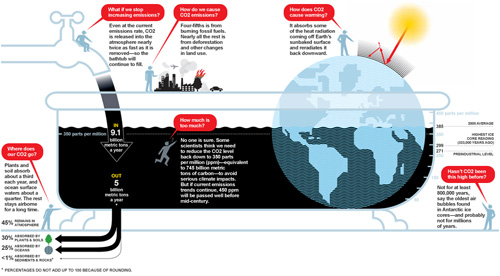

The Carbon Bathtub
Always looking for good explanations to aid understanding the effects of excess carbon in our atmosphere and the ways to take it out or sequester it permanently, I was impressed by the simplicity of the carbon baththub idea set forth in December edition 2009 of National Geographic magazine authored by Robert Kunzig. The first diagram was created by graphic artist Nigel Holmes and the second by Oliver Uberti to give added understanding to the study prepared by John Sterman of MIT and David Archer of University of Chicago, The Global Carbon Project. These scientists recognized the human limitations in understanding the conundrum we face today that as long as we pour CO2 into the atmosphere faster than Nature drains it out, the planet warms. And that extra carbon takes a long, long time to drain out of the tub.

Understanding the long term effects of our human consumption and resultant fossil fuel pollution may help all of us to shift our thinking and ultimately our actions into balancing our carbon production with effective ways of taking it out of the air or even avoiding putting it into the air in the first place. Nevertheless, there always seems to be controversy around the global warming issue and all the confusing, seemingly contradictive jargon is not helping. My own Dad recently retorted how “they” need to call it “global cooling” instead of “global warming” as he looked out of his window in St. Francisville, Louisiana on New Year’s day 2010 and saw three inches of packed snow on the ground with no melting in sight. All over the deep south USA, record low temperatures have been set this year and in Europe, people are snowed in across the continent. Meanwhile, below the equator, some places are simultaneously suffering record high temperatures. Just yesterday, January 9th, 2010, the temperature was pushing 120 degrees Farhenheit in Buenos Aires Argentina for the fourth day in a row.
I am not naïve enough to argue that extreme temperatures and weather patterns are direct results of global warming. No one can prove this yet. With a brother who is an accomplished geologist/paleontologist, I have debated ad nauseum for over 25 years whether our pollution will affect the delicate balance of Earth’s systems. He points out that the Earth has suffered countless climate changes over millions of years already and it has always basically taken care of itself no matter what. That is just the point. The Earth will be what it will be. We humans are the ones who are most delicate and need certain conditions to live, such as clean air and water, animals and plants for food.
According to John Sterman in the Global Carbon Project, a fundamental human flaw impedes action on global warming. He is not talking about greed, selfishness, ignorance or some other vice. He is talking about a cognitive limitation, “an important and pervasive problem in human reasoning” that he has documented by testing graduate students at the MIT Sloan School of Management. Sterman teaches system dynamics and he says his students, though very bright and schooled in calculus, lack an intuitive grasp of a simple, crucial system: a bathtub. Specifically, a bathtub with the tap running and the drain open. The water level can stand for many quantities in the modern world. In this example, we will use it for the level of carbon dioxide in the Earth’s atmosphere. The level in the tub only falls when the drain runs faster than the tap.
How does the carbon drain out of the tub? Plants, including trees, oceans and rocks all remove carbon up to approximately 60% from the atmosphere, but very slowly as pointed out by climatologist David Archer in his book The Long Thaw. It could take hundreds and maybe thousands of years for these natural features to remove most of the CO2 humans are spewing into the tub, especially if emissions do not decrease. Stopping the rise of CO2 will thus require combined measures including huge cuts in emissions from cars, power plants and factories until inflow no longer exceeds outflow.

Most of Sterman’s students, as well as those at other universities where his results have been replicated, didn’t understand the problem when it was described in the usual climate jargon. Most thought that simply stopping emissions from rising would stop the rise of CO2 in the atmosphere-as if a tap running steadily would not eventually overflow the tub. If MIT graduate students don’t get it, most politicians and voters and consumers probably don’t either. According to Sterman, “that means they think it is easier to stabilize greenhouse gases and stop warming than it is”.
By 2008, the level of CO2 in the tub was 385 parts per million (ppm) and rising by 2 or 3 ppm each year. To stop it at 450 ppm, a level many scientists consider dangerously high, the world would have to cut emissions by around 80 percent by 2050. While this may seem like an unrealistic goal, there are scientists and inventors around the world thinking of innovative new ways to deal with the extra carbon. I just heard of a pilot project in Brazil in which a “pill” is dropped into smokestacks of factories to neutralize the carbon before it is even spit into the air. Sterman was present at the recent convention in Copenhagen and used his software to show how a proposed emissions cut will immediately affect the level in the bathtub – and thus temperature of the planet. He also showed how increasing ways for the carbon to drain out of the tub and be stored permanently can bring down levels quicker. In other words, we need to turn off the tap PLUS enlarge the drain. Sterman believes people can learn this as shown by his own students.
I am thankful to scientists and graphic artists who are looking for ways to help us normal folks break through our own human logic and intellect and reach the deeper core of human understanding that it is important to balance NOW for future generations. When it boils down to it, (pun intended), NO ONE really KNOWS how much the Earth can take and what is actually going to happen. Why would we risk the worst case scenario? Especially when we do possess the genius and heart to find balance and solve many of the environmental challenges simply by releasing old ways of thinking and doing things and evolving with technology, hard work and some sacrifice. I know it does not help the naysayers jump on the bandwagon when governments around the globe are using the climate change issue to create new taxes which threaten to take money out of all of our pocketbooks and put in the hands of government which often is unaccountable and beyond our control. Are you surprised that governments want to use the heated issue to line their coffers? Are we going to let that stop us from creating and enacting our own solutions?
Leaving the threat of new environmental taxes aside, suffice it to say that there may be many reasons to disbelieve that climate change is actually happening as a result of excess carbon trapped in the atmosphere. To dispel often self serving opinions is very difficult and requires deep thought and intuitive reasoning in the face of conflicting information. And as I always say, even if you think we can withstand the ever growing quantity of carbon in the atmosphere, thus we have no reason to act now, the fact remains that we still need to plant as many trees all over the globe as humanly possible for all the other environmental benefits, services and products they provide us. You may argue against climate change, but it is pretty hard to argue against planting trees. Just in case?
Jennifer Smith, J.D. is Founder/President of Community Carbon Trees –CostaRica.com Sponsor One Tree at a Time for Future Generations to be planted by Tico families in community for a myriad of environmental and social benefits.





